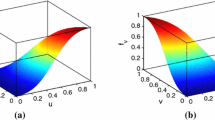Abstract
The paper describes the application of front tracking to the polymer system, an example of a nonstrictly hyperbolic system. Front tracking computes piecewise constant approximations based on approximate Riemann solutions and exact tracking of waves. It is well known that the front tracking method may introduce a blowup of the initial total variation for initial data along the curve where the two eigenvalues of the hyperbolic system are identical. It is demonstrated by numerical examples that the method converges to the correct solution after a finite time, and that this time decreases with the discretization parameter.
For multidimensional problems, front tracking is combined with dimensional splitting, and numerical experiments indicate that large splitting steps can be used without loss of accuracy. Typical CFL numbers are in the range 10–20, and comparisons with Riemann free, high-resolution methods confirm the high efficiency of front tracking.
The polymer system, coupled with an elliptic pressure equation, models two-phase, three-component polymer flooding in an oil reservoir. Two examples are presented, where this model is solved by a sequential time stepping procedure. Because of the approximate Riemann solver, the method is non-conservative and CFL numbers must be chosen only moderately larger than unity to avoid substantial material balance errors generated in near-well regions after water breakthrough. Moreover, it is demonstrated that dimensional splitting may introduce severe grid orientation effects for unstable displacements that are accentuated for decreasing discretization parameters.
Similar content being viewed by others
References
Bratvedt, F., Bratvedt, K., Buchholz, C. F., Gimse, T., Holden, H., Holden, L. and Risebro, N. H.: 1993, Frontline and frontsim: Two full scale, two-phase, black oil reservoir simulators based on front tracking, Surv. Math. Ind. 185-215.
Dafermos, C.: 1972, Polygonal approximations of solutions of the initial value problem for a conservation law, J. Math. Anal. Appl. 38, 33-41.
Glimm, J.: 1965, Solutions in the large for nonlinear hyperbolic systems of equations, Comm. Pure Appl. Math. 18, 697-715.
Holdahl, R., Holden, H. and Lie, K.-A.: 1999, Unconditionally stable splitting methods for the shallow water equations, BIT 39(3), 451-472.
Holden, H., Holden, L. and Høegh-Krohn, R.: 1988, A numerical method for first order nonlinear scalar conservation laws in one-dimension, Comput. Math. Appl. 15(6-8), 595-602.
Holden, H., Lie, K.-A. and Risebro, N. H.: 1999, An unconditionally stable method for the Euler equations, J. Comp. Phys. 150(1), 76-96.
Holden, H., Karlsen, K. H. and Lie, K.-A.: Operator splitting methods for degenerate convection-diffusion equations II: numerical examples with emphasis on reservoir simulation, Submitted.
Holing, K., Alvestad, J. and Trangenstein, J. A.: 1990, The use of second-order Godunov methods for simulating EOR processes in realistic reservoir models, in: D. Guérillot and O. Guillon (eds), 2nd European Conference on the Mathematics of Oil Recovery, pp. 101-111.
Isaacson, E.: 1981, The global solution of a Riemann problem for a non-strictly hyperbolic system of conservation laws arising in enhanced oil recovery, Preprint, The Rockefeller University.
Isaacson, E. and Temple, B.: 1986, Analysis of a singular hyperbolic system of conservation lawsJ. Differential Equations 65, 250-268.
Jiang, G.-S. and Tadmor, E.: 1998, Non-oscillatory central schemes for multidimensional hyperbolic conservation laws, SIAM J. Sci. Comp. 19, 1892-19177.
Johansen, T., Tveito, A. and Winther, R.: 1989, A Riemann solver for a two-phase multicomponent process, SIAM J. Sci. Statist. Comp. 19, 541-566.
Johansen, T. and Winther, R.: 1988, The solution of the Riemann problem for a hyperbolic system of conservation laws modelling polymer flooding, SIAM J. Math. Anal. 19, 541-566.
Klingenberg, C. and Risebro, N. H.: Stability of a resonant system of conservation laws modeling polymer flow with gravitation, J. Diff. Eqn. to appear.
Lie, K.-A.: Front tracking for one-dimensional quasilinear hyperbolic equations with variable coefficients, Numerical Algorithms, to appear.
Lie, K.-A., Karlsen, K. H. and Haugse, V.: 1998, Dimensional splitting with front tracking and adaptive grid refinement, Numer. Methods Partial Diff. Equ. 14(5), 627-648.
Lie, K.-A.: 1999, A dimensional splitting method for quasilinear hyperbolic equations with variable coefficients, BIT 39(4), 683-700.
Potempa, T.: 1982, Finite element methods for convection dominated transport problems, Ph.D. thesis, Rice University.
Risebro, N. H.: 1993, A front-tracking alternative to the random choice method, Proc. Am. Math. Soc. 117(4), 1125-1139.
Risebro, N. H. and Tveito, A.: 1992, A front tracking method for conservation laws in one dimension, J. Comp. Phys. 101(1), 130-139.
Risebro, N. H. and Tveito, A.: 1991, Front tracking applied to a nonstrictly hyperbolic system of conservation laws, SIAM J. Sci. Stat. Comput. 12(6), 1401-1419.
Sethian, J. A., Chorin, A. J. and Concus, P.: 1983, Numerical solution of the Buckley-Leverett equations, in SPE Reservoir Simulation Symposium, pp. 197-204, SPE 12254.
Shubin, G. R. and Bell, J. B.: 1984, An analysis of the grid orientation effect in numerical simulation of miscible displacement, Comp. Meth. Appl. Mech. Eng. 47, 47-71.
Temple, B.: 1982, Global solution of the Cauchy problem for a class of 2 × 2 nonstrictly hyperbolic conservation laws, Adv. in Appl. Math. 3, 335-375.
Tveito, A. and Winther, R.: 1991, Existence, uniqueness and continuous dependence for a system of conservation laws modelling polymer flooding, SIAM J. Math. Anal. 22, 905-933.
Tveito, A. and Winther, R.: 1995, The solution of the nonstrictly hyperbolic conservation law may be hard to compute, SIAM J. Sci. Comp. 16, 320-329.
Yanosik, J. L. and McCracken, T. A.: 1979, A nine point finite difference simulator for realistic predictions of adverse mobility ratio displacements, SPE J. 8, 252-262.
Wendroff, B.: 1993, An analysis of front tracking for chromatography, Acta Appl. Math. 30(3), 265-285.
Author information
Authors and Affiliations
Corresponding author
Rights and permissions
About this article
Cite this article
Haugse, V., Karlsen, K.H., Lie, KA. et al. Numerical Solution of the Polymer System by Front Tracking. Transport in Porous Media 44, 63–83 (2001). https://doi.org/10.1023/A:1010740024800
Issue Date:
DOI: https://doi.org/10.1023/A:1010740024800




